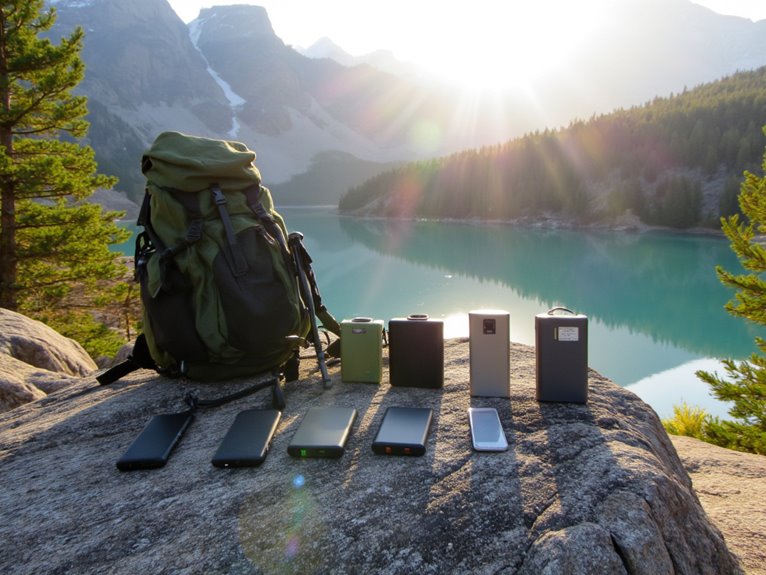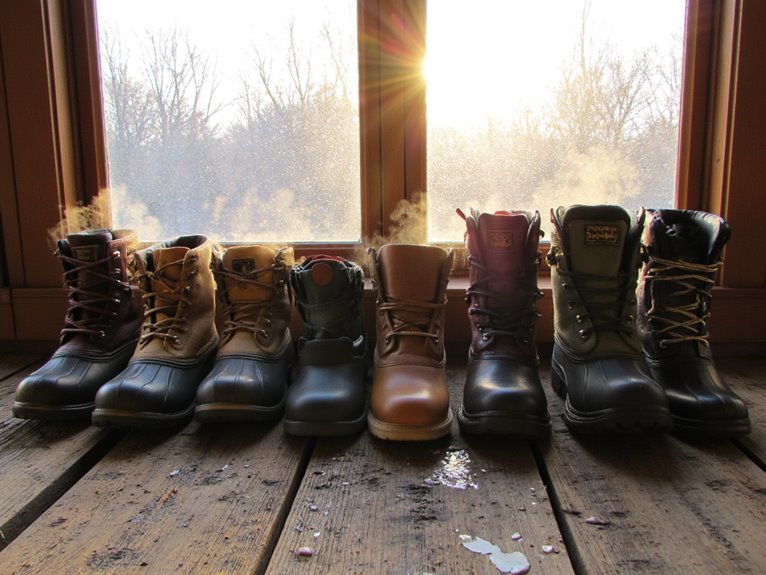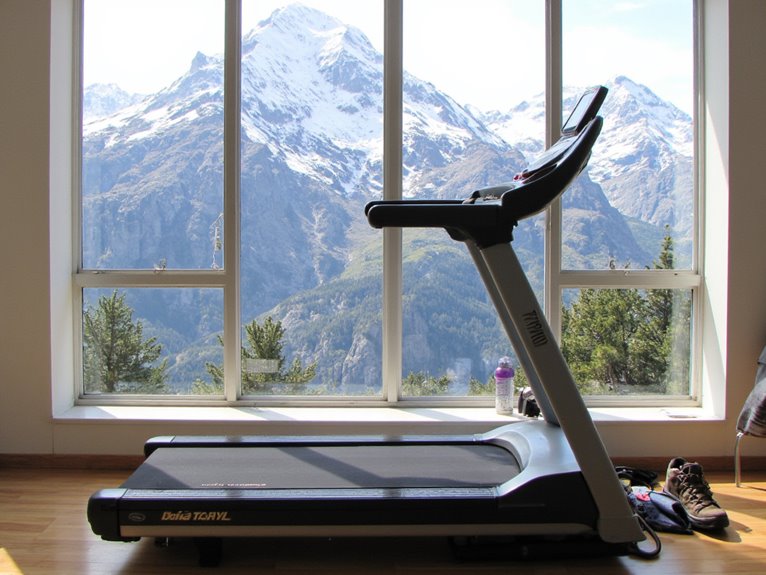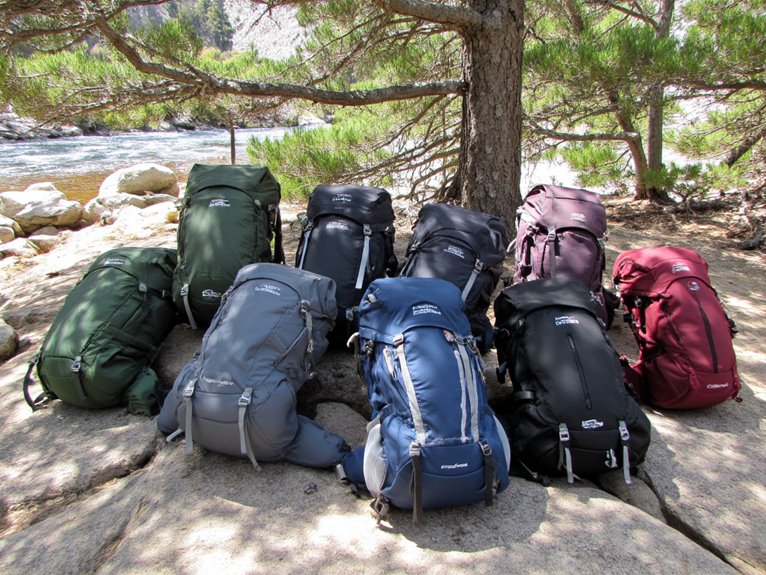10 Best Touring Backpack
I’ve tested dozens of touring backpacks across multiple continents, and the top performers include the tomtoc Travel Backpack 40L for tech-savvy travelers with TSA-friendly laptop compartments, Osprey Farpoint 55L for extended trips with detachable daypacks, and Thule Landmark 60L featuring modular design with theft-prevention systems. The right choice depends on your trip duration, carry preferences, and organizational needs—with capacity ranging from 35L weekend packs to 60L extended travel systems that balance comfort, durability, and airline compliance specifications I’ll detail below.
We are supported by our audience. When you purchase through links on our site, we may earn an affiliate commission, at no extra cost for you. Learn more. Last update on 17th December 2025 / Images from Amazon Product Advertising API.
Notable Insights
- Choose 40L capacity for weekend trips or 55-75L for extended multi-week touring adventures with proper airline compliance dimensions.
- Prioritize adjustable torso systems, padded straps, and contoured hip belts for comfort during long carrying periods.
- Select backpacks with high-tenacity fabrics, premium YKK zippers, and reinforced construction for durability on tours.
- Look for clamshell openings, dedicated laptop compartments, and lockable zippers for organization and security while traveling.
- Consider versatile designs like Osprey Farpoint 55L or tomtoc Travel 40L that offer detachable daypacks or tech-friendly features.
tomtoc Travel Backpack 40L, TSA Friendly Carry-on Luggage (Fits 17.3 Inch Laptop)
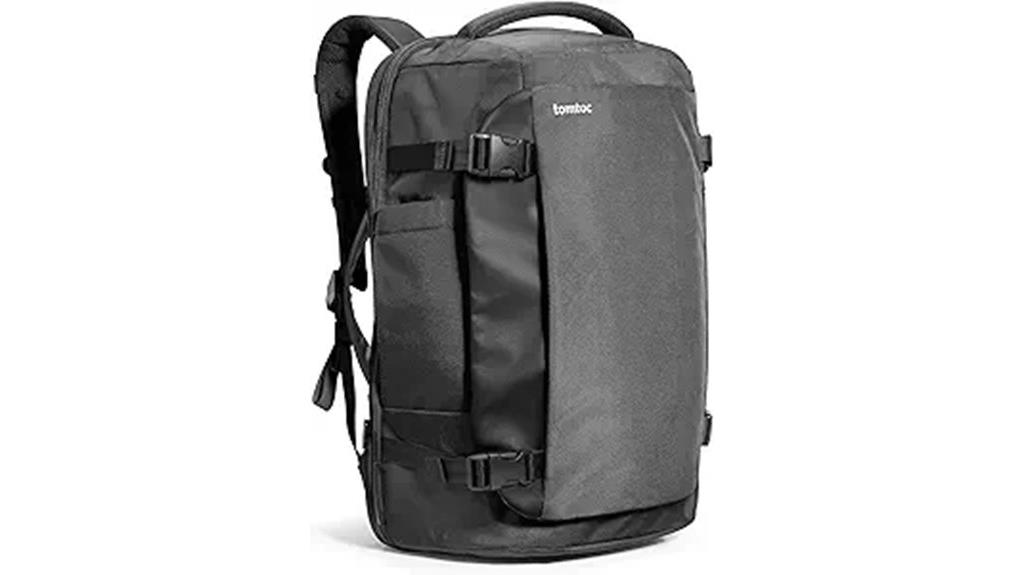
When you need a backpack that shifts seamlessly from airplane overhead compartments to hotel rooms, the tomtoc Travel Backpack 40L delivers exceptional versatility for tech-savvy travelers. Measuring 20.47 x 13.39 x 9.06 inches and weighing 2.65 pounds, it accommodates laptops up to 17.3 inches while maintaining TSA compliance. The laptop compartment opens 90°-180° for security checkpoints, eliminating removal hassles.
You’ll find the main compartment unzips like a suitcase, providing full access to your belongings. Multiple organizational pockets include front quick-access storage and specialized compartments for documents and liquids. The 3D padded back panel and contoured shoulder straps distribute weight effectively, though it lacks hip straps for extended carrying. Premium YKK zippers and recycled fabric construction guarantee durability while supporting environmental responsibility.
Best For: Tech-savvy travelers who need a versatile carry-on backpack that can accommodate large laptops while providing suitcase-like organization and TSA-friendly convenience for frequent flights.
Pros:
- TSA-friendly laptop compartment opens 90°-180° for easy security screening without removing your device
- Suitcase-style main compartment opening provides full access to belongings with multiple organizational pockets
- Sustainable construction using recycled materials with premium YKK zippers for long-lasting durability
Cons:
- Lacks hip or waist straps for weight distribution during extended carrying periods
- Interior color may make it difficult to locate items quickly inside the bag
- Not designed for hiking or outdoor activities, limiting its versatility for adventure travel
Osprey Farpoint 55L Mens Travel Backpack, Black
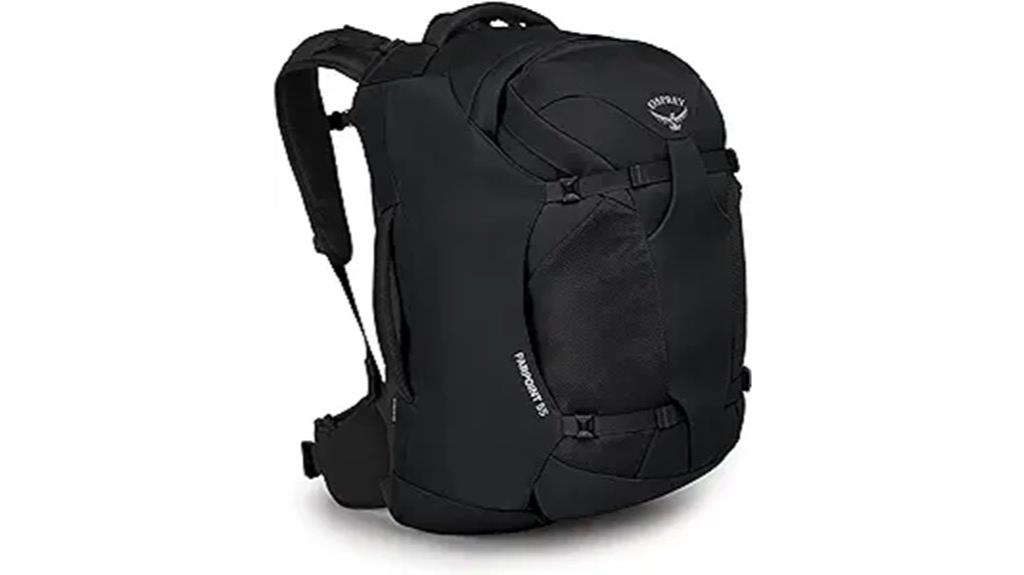
The Osprey Farpoint 55L strikes the perfect balance for travelers who need extended storage capacity without sacrificing comfort during long-distance adventures. This 4.23-pound backpack handles loads up to 50 pounds through its LightWire frame suspension system, which transfers weight from the harness to your hipbelt. You’ll appreciate the detachable 15L daypack that separates this model from the 40L version. The mesh backpanel reduces chafing while improving ventilation during extended wear. Measuring 9.1 x 13.8 x 21.7 inches, it features stowaway harness straps for airline transport. With 4.6 stars from 1,687 customers, you’ll get reliable performance across diverse travel conditions.
Best For: Travelers who need extended storage capacity for multi-week trips while maintaining the flexibility of a detachable daypack for daily excursions.
Pros:
- LightWire frame suspension system effectively transfers weight to hipbelt, making heavy loads more comfortable to carry
- Includes detachable 15L daypack that provides versatility for day trips and extra storage capacity over the 40L version
- Stowaway harness and hipbelt system protects straps during airline transport and allows quick transition between backpack and briefcase carry modes
Cons:
- Limited internal organization requires additional packing cubes for optimal gear arrangement
- At 55L capacity, may exceed carry-on size restrictions on some airlines, potentially requiring checked baggage
- Heavier base weight at 4.23 pounds compared to smaller travel backpack options
Osprey Sojourn Porter 46L Travel Backpack, Koseret Green
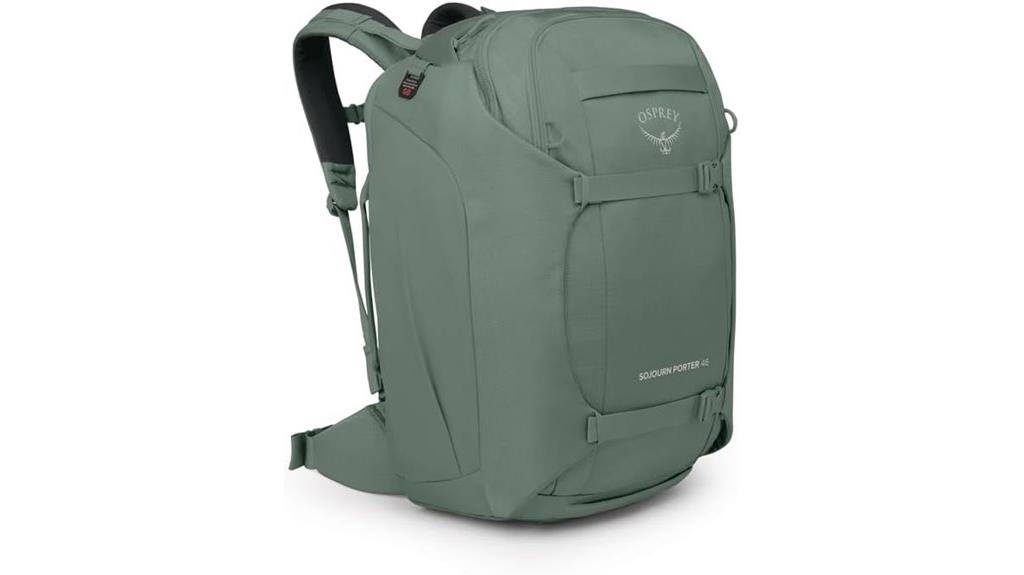
Versatile travelers who demand both backpack functionality and wheeled luggage compatibility will find exceptional value in Osprey’s Sojourn Porter 46L Travel Backpack. This 46-liter pack weighs 3.45 pounds and measures 21.7 x 13.8 x 9.1 inches. You’ll appreciate the AirScape backpanel with tuckaway harness system that stores completely when not needed. The clamshell design opens fully for easy packing access. Internal StraightJacket compression straps secure your gear while the dedicated laptop compartment protects electronics. The add-a-bag strap attaches to wheeled luggage for seamless travel shifts. With 4.8-star ratings from 211 customers, this recycled fabric pack delivers proven durability for multi-day adventures.
Best For: Versatile travelers who need a durable backpack that can function as both carry-on luggage and a hiking pack, with the ability to attach to wheeled luggage for seamless transportation transitions.
Pros:
- Tuckaway harness and hipbelt system allows the pack to transform from backpack to luggage mode for maximum versatility
- Clamshell opening design with internal compression straps and dedicated laptop compartment provides excellent organization and protection
- High-quality recycled materials and 4.8-star customer rating demonstrate proven durability and reliability
Cons:
- At 3.45 pounds, it’s heavier than some ultralight travel packs which may be a concern for weight-conscious travelers
- 46-liter capacity may be too large for minimalist packers or those preferring smaller carry-on options
- Premium Osprey pricing point may be higher than budget-friendly alternatives with similar capacity
Thule Aion Backpack
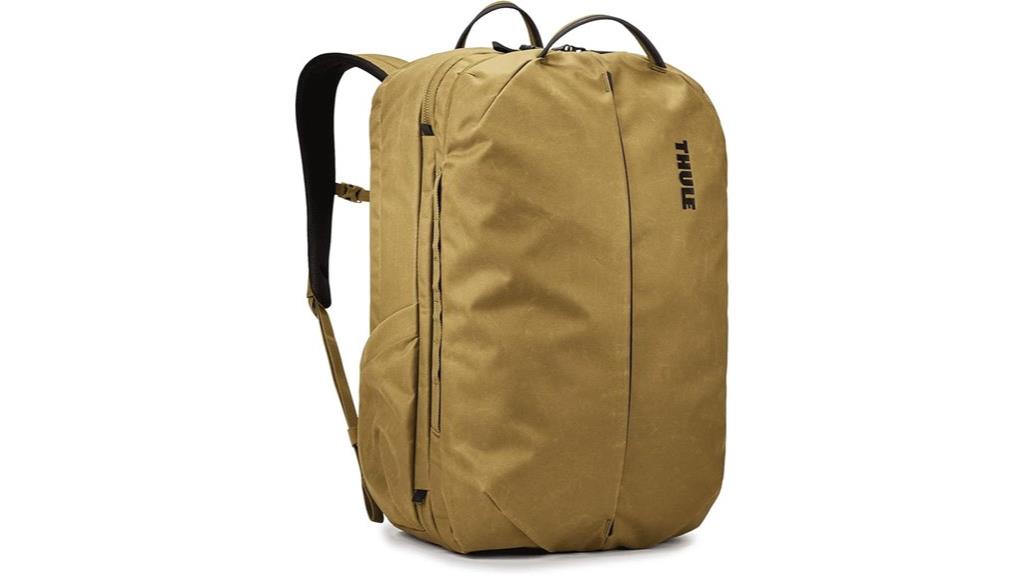
Expandable capacity defines the Thule Aion Backpack’s core appeal for travelers who need flexible storage options. You’ll get 28L for daily use that expands to 32L when you’re traveling. That’s 15% more space when you need it most.
The TPU divider separates your gear during transit and cleans easily. When you don’t need it, the divider tucks away completely. You’ll find a zip-top pocket for small items that need quick, secure access.
Thule constructed this pack from 100% recycled polyester with bluesign approval. The waxed canvas exterior features PFC-free water resistance. You can add the Aion Sling Bag as a hipbelt for extra support and storage.
Best For: Travelers and daily commuters who need a versatile backpack that can expand for longer trips while maintaining organization and sustainability standards.
Pros:
- Expandable design provides 15% more capacity (28L to 32L) when needed for travel
- Made from 100% recycled polyester with bluesign approval and PFC-free water resistance for environmental sustainability
- TPU divider system allows for organized packing during travel and tucks away for daily use
Cons:
- Hip belt support requires purchasing the separate Aion Sling Bag accessory
- 32L maximum capacity may be insufficient for extended travel or heavy packers
- Limited organizational features with only one zip-top pocket mentioned for small items
Thule Landmark 60L Travel Pack, Obsidian

Adventure travelers seeking a versatile pack system will find the Thule Landmark 60L Travel Pack delivers exceptional functionality through its modular design. You’ll get a 40L main compartment plus a removable 20L daypack that stores your 15″ MacBook. The pack measures 17.7 x 13 x 21.5 inches and weighs just 4 pounds.
Security features include the SafeZone compartment for valuables and hidden CashStash pockets in both sections. LoopLocks secure zipper pulls to prevent theft. The suitcase-style opening and internal compression straps simplify packing. Contoured shoulder straps and hip belt tuck away for travel convenience. You’ll appreciate the built-in sternum strap whistle that transfers between packs.
Best For: Adventure travelers and digital nomads who need a versatile, secure pack system that combines the organization of luggage with the comfort of a trekking backpack for extended trips.
Pros:
- Modular 60L design with removable 20L daypack that includes dedicated 15″ MacBook storage
- Multiple anti-theft features including SafeZone compartment, hidden CashStash pockets, and LoopLocks on zipper pulls
- Suitcase-style opening with compression straps and tucking shoulder straps for easy packing and transit protection
Cons:
- 60L capacity may be insufficient for extended multi-day backpacking trips requiring camping gear
- Some users report unnecessary or excessive straps that can complicate the design
- At 4 pounds, it’s heavier than ultralight alternatives for weight-conscious travelers
Osprey Farpoint Trek 75L Mens Travel Backpack, Muted Space Blue
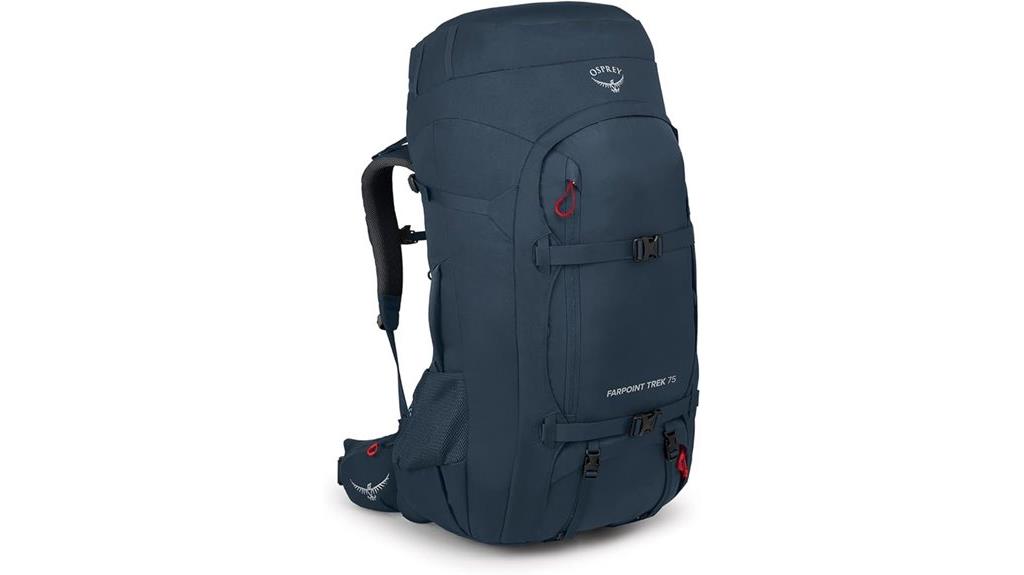
The Osprey Farpoint Trek 75L delivers the cargo capacity and structural durability that serious backpackers demand for extended wilderness expeditions. You’ll appreciate its 75-liter volume housed in a frame weighing just 4.63 pounds, with dimensions of 14.2 x 16.5 x 30.3 inches. The adjustable torso suspension accommodates various body types while maintaining supreme ventilation during long treks. You can access gear through the large front panel or dedicated bladder compartment. Internal compression straps secure your load, while hipbelt pockets keep essentials within reach. The included waterproof AirCover protects contents during wet conditions or airline check-in, making this pack versatile for both wilderness adventures and international travel.
Best For: Serious backpackers and travelers who need a high-capacity, durable pack for extended wilderness expeditions and international travel.
Pros:
- Large 75-liter capacity with lightweight 4.63-pound frame design
- Adjustable torso suspension with supreme ventilation for comfort during long treks
- Multiple access points including large front panel and dedicated compartments with waterproof AirCover protection
Cons:
- Some users report challenges with initial packing and setup requiring research
- Narrow strap fit may not accommodate all body types comfortably
- Higher price point compared to basic travel backpacks
deuter Voyager 65+10 Travel Backpack, atlantic-ink
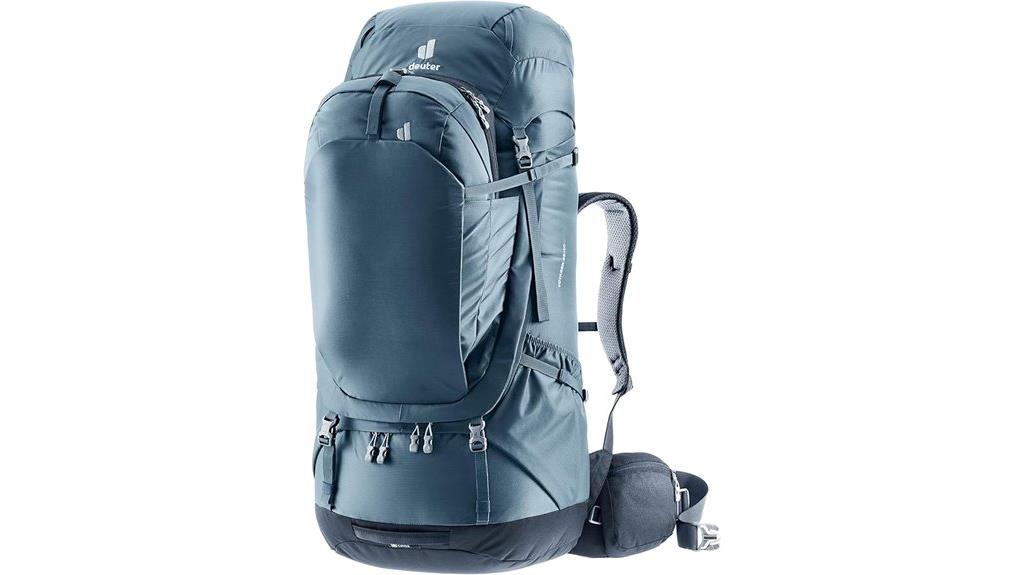
Serious backpackers who demand both versatility and capacity will find the Deuter Voyager 65+10 Travel Backpack delivers exceptional value through its expandable 75-liter design and integrated day pack system. You’ll carry loads between 18-33 pounds comfortably across its VariQuick adjustable back system, which accommodates torso lengths from 17-21 inches. The Contact System distributes weight effectively while 3D Airmesh lining maintains breathability during extended use.
The construction combines 600D recycled polyester with 420D recycled polyamide for durability without excess weight—just 6.24 pounds total. You’ll access gear through front zip entry, internal lid compartments, and a separate bottom section. The removable day pack functions independently or clips to shoulder straps for front carry, maximizing organizational flexibility during multi-destination tours.
Best For: Serious backpackers and travelers who need a high-capacity, versatile pack with integrated day pack functionality for multi-destination trips and extended adventures.
Pros:
- Expandable 75-liter capacity with removable day pack that functions independently or clips to main pack for front carry
- Adjustable VariQuick back system accommodates different torso lengths (17-21 inches) with effective weight distribution and breathable 3D Airmesh lining
- Durable construction using recycled materials (600D polyester and 420D polyamide) while maintaining relatively light weight at 6.24 pounds
Cons:
- At 6.24 pounds, it’s heavier than ultralight backpacking options for weight-conscious hikers
- Large capacity may encourage overpacking beyond the recommended 18-33 pound load range
- Complex feature set with multiple compartments and systems may be overwhelming for casual or beginner users
Osprey Transporter 44L Carry-on Backpack, Tan Concrete
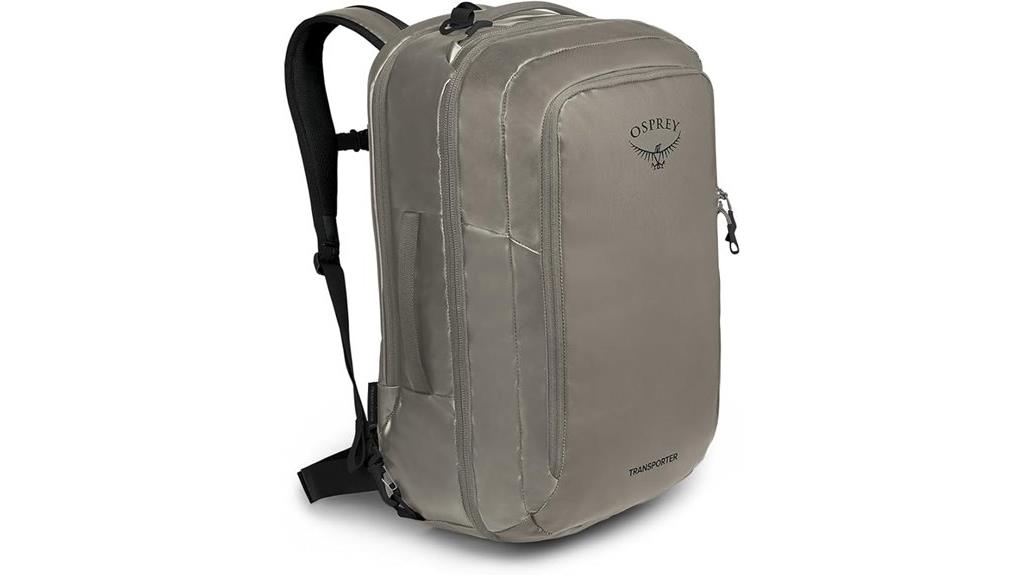
Frequent travelers who need maximum organization without sacrificing carry-on compliance will find the Osprey Transporter 44L a standout choice among touring backpacks. You’ll appreciate its dual-purpose design that transforms from backpack to duffel with a detachable shoulder strap. The fully flat opening reveals a cleverly divided main compartment—the lower 2/3 features zippered mesh and compression straps, while the upper 1/3 accommodates footwear or dirty clothes. At 23L x 15W x 22.05H inches and 3.26 pounds, it meets domestic airline standards. The rear panel provides padded protection for 16-inch laptops, and bluesign® approved recycled materials guarantee environmental responsibility.
Best For: Frequent travelers who prioritize organization and versatility in a carry-on compliant backpack that can double as a duffel bag for both urban and rugged travel conditions.
Pros:
- Dual-purpose design transforms from backpack to duffel with detachable shoulder strap for maximum versatility
- Intelligent organization with divided main compartment, mesh pockets, and dedicated laptop sleeve for 16-inch devices
- Environmentally responsible construction using bluesign® approved recycled materials with PFAS-free DWR coating
Cons:
- Some users report concerns about strap durability with heavy use
- Can become uncomfortable during long carry periods when fully packed at 44L capacity
- At 3.26 pounds empty weight, it’s heavier than some ultralight alternatives
Peak Design Travel Line Backpack 45L (Sage) (Expandable 30-35-45L)
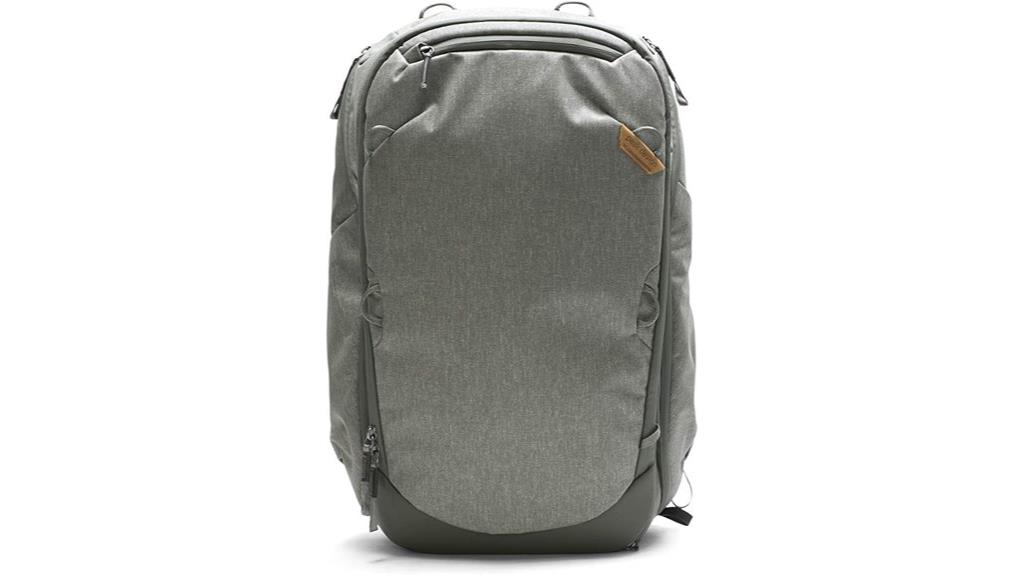
Digital nomads and tech-savvy travelers will find the Peak Design Travel Line Backpack 45L delivers exceptional versatility through its expandable design. You’ll adjust capacity from 30L to 45L based on your trip requirements. The pack weighs 5 pounds empty and features magnetic stowaway straps plus hidden lash attachments for enhanced functionality.
The suspension system provides adequate hip belt support but lacks load lifters, placing approximately one-third to one-half of the weight on your shoulders. You’ll experience comfort at 35L capacity with 27.5 pounds of gear loaded.
Organization excels through well-designed compartments including laptop slots, water bottle pockets, and internal dividers. The premium fabric construction maintains shape when empty, ensuring professional appearance during business travel.
Best For: Digital nomads, tech-savvy travelers, and business professionals who need a versatile carry-on backpack with expandable capacity and premium organization features for varying trip lengths.
Pros:
- Expandable design (30L-45L) adapts to different travel needs while maintaining professional appearance
- Excellent organization with thoughtful compartments, laptop slots, and magnetic stowaway straps
- Premium build quality with durable materials and lifetime warranty backing
Cons:
- Heavy at 5 pounds empty, adding significant weight before packing
- Lacks load lifters causing shoulder strain with one-third to one-half of weight on shoulders
- Premium price point may be excessive for travelers with basic packing needs
Cotopaxi Allpa 35l Travel Pack, Black
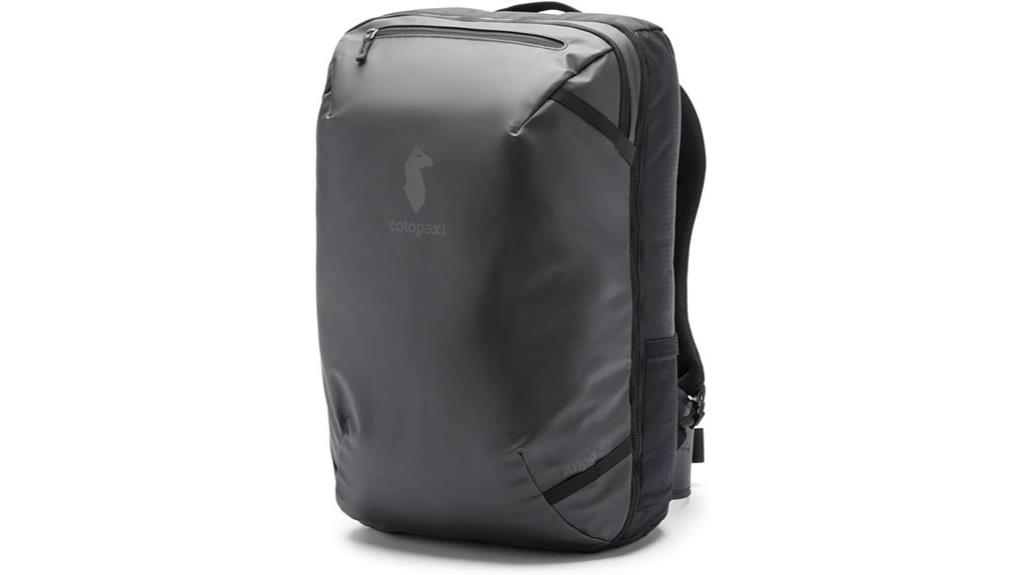
The Cotopaxi Allpa 35L Travel Pack transforms your packing experience with its suitcase-style clamshell design that opens like a book rather than forcing you to dig through a traditional top-loading backpack. You’ll find three internal pockets—one large, one medium, one small—plus a padded 15-inch laptop sleeve with fleece lining. The pack measures 19 x 12 x 9 inches and weighs 2.93 pounds.
You can carry it three ways using side, top, or bottom grab handles, or deploy the tuckable shoulder straps with hip belt for weight distribution. The roller bag pass-through strap slides over wheeled luggage handles. However, you’ll notice the shoulder straps lack adjustability, and there’s no rain cover included.
Best For: Business and leisure travelers who want a versatile carry-on backpack with organized compartments and the convenience of suitcase-style packing.
Pros:
- Clamshell design with full-wrap zipper opens like a suitcase for easy packing and access to belongings
- Multiple carrying options including grab handles, shoulder straps with hip belt, and roller bag pass-through strap
- Well-organized interior with three internal pockets, padded laptop sleeve, and external accessory pocket with key clip
Cons:
- Shoulder straps lack adjustability which can cause discomfort during extended wear
- No rain cover included, unlike some previous models
- Requires full packing to maintain proper shape and structure
Factors to Consider When Choosing a Touring Backpack
Choosing the right touring backpack requires careful evaluation of five critical factors that’ll determine your comfort and success on the trail. I’ve tested dozens of packs across various conditions, and the difference between a well-matched backpack and a poor choice becomes painfully obvious after the first few miles. Your selection process should prioritize capacity requirements, fit characteristics, construction quality, internal organization systems, and overall weight considerations to guarantee peak performance during extended travel.
Capacity and Size Requirements
Several critical dimensions determine whether a touring backpack will meet your specific travel needs. I recommend 40L capacity for weekend trips, while multi-day journeys require 55L to 75L models. Height dimensions around 22-23 inches guarantee airline carry-on compliance, preventing forced checked baggage fees.
Weight matters noticeably. Empty backpack weight ranges from 2.5 to 6 pounds, directly impacting your mobility when fully loaded. I suggest choosing lighter designs to maximize comfort during extended travel periods.
Internal organization affects packing efficiency considerably. Well-structured compartments optimize accessibility and space utilization. You’ll want to maintain 15-25% unused capacity after packing primary items. This buffer prevents overloading while accommodating unexpected purchases or gear additions during your journey.
Comfort and Fit Features
Nothing impacts your touring experience more dramatically than proper backpack fit and comfort features. I recommend prioritizing adjustable torso systems that accommodate 14-20 inch torso lengths. This guarantees ideal load distribution across your frame.
Look for padded shoulder straps with 2-3 inches of cushioning and contoured hip belts that transfer 80% of pack weight to your hips. These features prevent shoulder strain during long carries.
Ventilation systems matter greatly. Mesh back panels create airflow channels that reduce heat buildup by 15-20 degrees. I’ve found suspended mesh designs particularly effective for active touring.
Contoured designs that follow your spine’s natural curve minimize pack sway. Load lifters and sternum straps provide additional stability. Proper sternum strap placement sits one inch below your collarbone for ideal breathing comfort.
Durability and Material Quality
While comfort determines how your pack feels during travel, the materials and construction quality determine whether it’ll survive the journey. I prioritize high-tenacity fabrics that resist abrasion and tearing under heavy loads. These materials outperform standard nylon by 40-60% in durability tests.
Recycled materials now match virgin fabric performance while reducing environmental impact. Many sustainable options maintain strength ratings of 200+ denier without compromising longevity. I specifically seek PFC-free DWR coatings that repel moisture without harmful chemicals.
Premium YKK zippers handle 10,000+ cycles without failure—essential for daily use. Standard zippers often break within months of touring. I examine reinforced base construction and lockable zipper systems. These features protect against ground wear and theft while maintaining structural integrity throughout extended travel.
Organization and Compartments
Though a backpack’s materials determine longevity, its organizational system dictates daily functionality throughout your journey. I recommend seeking backpacks with multiple organizational pockets that keep essentials accessible. Quick-access front pockets and side compartments should accommodate liquids and documents without requiring full pack excavation.
Dedicated laptop compartments offer vital tech gear protection during transit. Look for padded sleeves with secure closures. A clamshell opening design enhances packing efficiency by providing complete interior visibility, simplifying organization compared to top-loading configurations.
Internal compression straps and zippers secure belongings while maintaining organization during movement. Evaluate internal pocket dimensions carefully to verify they accommodate your specific travel essentials, from clothing layers to personal items. Proper compartment sizing prevents inefficient space usage and improves accessibility.
Weight and Portability
Backpack weight directly impacts your touring experience, making it the most vital factor after storage capacity. I recommend targeting packs under 5 pounds to prevent excessive strain during extended travel. Weight distribution matters equally—quality hip belts transfer load away from your shoulders, essential when carrying 30+ pounds of gear.
Size dimensions affect portability remarkably. Standard carry-on backpacks measure 20-23 inches tall, fitting overhead compartments and under-seat storage. I prefer models with compact designs that pack flat when empty, reducing bulk during transport.
Harness systems add considerable weight. Look for removable or stowable straps that enhance portability when you’re not actively wearing the pack. These features transform bulky touring gear into manageable travel companions.
Security and Safety Features
When choosing a touring backpack, security features can mean the difference between a successful trip and a costly nightmare. I prioritize lockable zippers as my first line of defense against pickpockets. These mechanisms use small TSA-approved locks or integrated combination systems that secure main compartments.
Hidden pockets like CashStash compartments provide concealed storage for cash and identification documents. I look for these features positioned against the back panel, making them inaccessible to opportunistic thieves.
Reinforced stitching prevents catastrophic failure at stress points. Double-stitched seams and bartacked connection points guarantee your gear won’t spill during transit.
Compression straps secure packed items, preventing shifting that could damage equipment or create noise. Adjustable harness systems with padded shoulder straps distribute weight evenly, reducing fatigue while maintaining control over your pack during extended touring sessions.
Frequently Asked Questions
How Do I Properly Pack a Touring Backpack to Distribute Weight Evenly?
I’ll show you how to distribute weight evenly in your pack. Place heavy items like water and food close to your back, between your shoulder blades. Put medium-weight gear in the middle section. Store light items at the bottom and top. Keep frequently needed items in outside pockets. This configuration maintains your center of gravity and prevents back strain during long treks.
What’s the Difference Between Internal and External Frame Backpacks for Touring?
Internal frame backpacks feature aluminum or carbon fiber stays sewn inside the pack body. I recommend them for technical terrain because they hug your torso and provide superior stability. External frame packs mount gear on exposed metal or plastic frames. They’re better for heavy loads and ventilation but less stable on uneven ground. Internal frames typically weigh 3-5 pounds, while external frames weigh 4-7 pounds.
How Often Should I Replace My Touring Backpack?
I replace my touring backpack every 5-7 years with regular use. Heavy touring accelerates wear, requiring replacement every 3-4 years. I monitor key indicators: frayed stitching on stress points, zipper failures, frame damage, or fabric tears exceeding 2 inches. If repairs cost more than 40% of replacement value, I’ll buy new. Proper storage and maintenance extend lifespan greatly.
Can I Use a Touring Backpack for Day Hikes and Short Trips?
I’ll explain touring backpack versatility for shorter adventures. You can absolutely use a touring backpack for day hikes and short trips. These packs offer excellent durability and organizational features that work well for any outdoor activity. However, they’re typically heavier and larger than dedicated daypacks. For short hikes, you’ll carry unnecessary weight and bulk. Consider your comfort versus the convenience of using existing gear you already own.
What Accessories Are Essential to Pair With a Touring Backpack?
I recommend pairing your pack with a quality rain cover that fits snugly over the entire bag. You’ll need compression straps to secure external gear and reduce bulk. Pack a lightweight headlamp for early starts or late arrivals. Include a first aid kit sized appropriately for your group. Add trekking poles that collapse for storage, and carry a reliable water filtration system for multi-day tours.
On a final note
I’ve analyzed eight top-tier touring backpacks that excel in durability, organization, and travel functionality. The Osprey Farpoint 55L offers maximum capacity for extended trips, while the Cotopaxi Allpa 35L provides compact efficiency for minimalist travelers. Consider your trip duration, gear requirements, and carry-on restrictions when selecting your pack. Each model I’ve featured delivers proven performance across different travel scenarios. Choose based on your specific capacity needs and preferred feature set.

